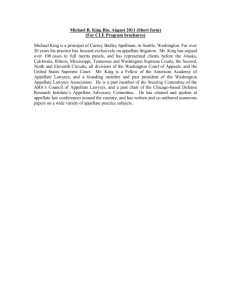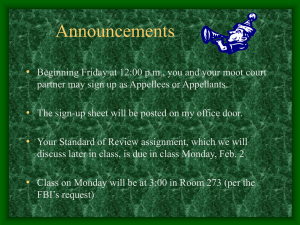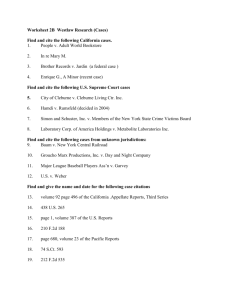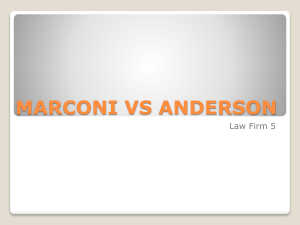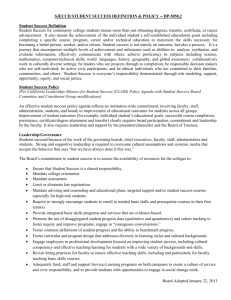Read More... - Davis Graham & Stubbs LLP
advertisement
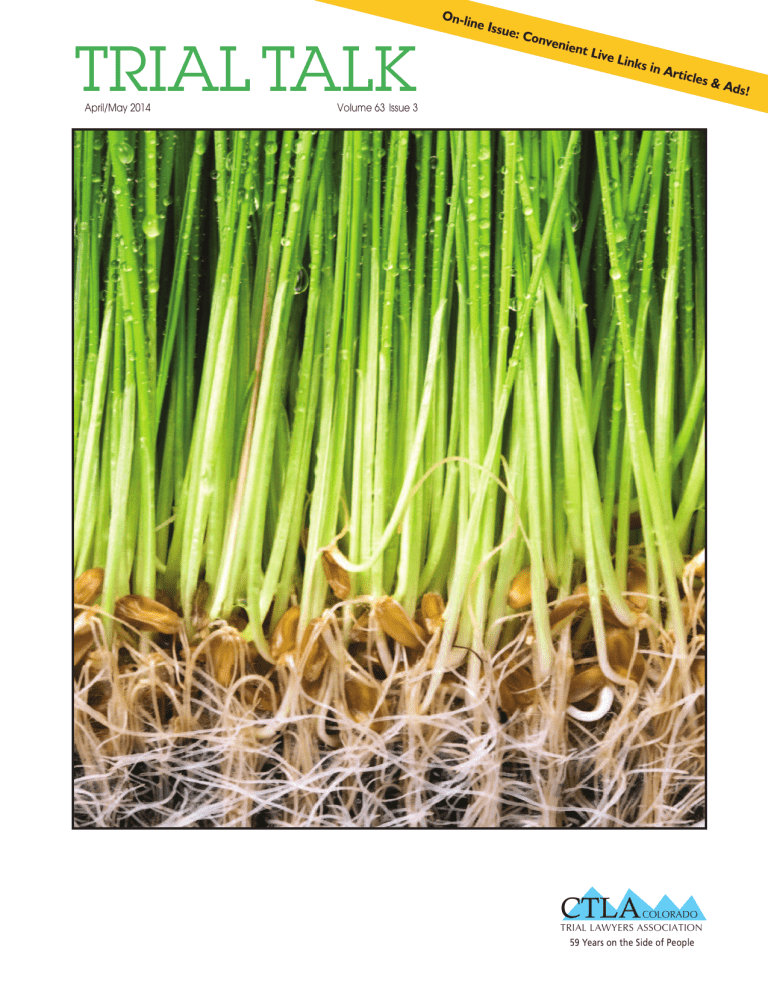
TRIAL TALK April/May 2014 On-li ne Iss ue: C o nveni e nt Liv e Links in A rticle s&A Volume 63 Issue 3 CTLA coloraDo Trial lawyers associaTion 59 Years on the Side of People ds! Brenton | APPELLATE PRACTICE & PROCEDURE Understand the Mandate Rule to Avoid Snatching Defeat from the Jaws of Victory By Kyle W. Brenton, Esq. Introduction court) and the mandate is largely pragmatic. After the opinion issues, the parties have the opportunity to petition for rehearhen the appellant wins an appeal, the opinion often ing or certiorari, and the appellate court must thus retain ends with two words that sound like music to the jurisdiction over the case to allow consideration of such a victor’s ears: “REVERSED and REMANDED.” But while petition. In this first sense the mandate, while important the vast bulk of the parties’ work aims (understandably) for reasons of timing and procedure, is largely a formality. toward the first of those two words, few trial or appellate practitioners devote enough attention to the second. The The second sense in which courts and practitioners use appellant may know precisely how the district court erred the term “mandate” is much more important. In the words and exactly why it should be reversed, but unless the attorney of the Tenth Circuit, the mandate “consists of our instrucrepresenting the appellant has given thought to the shape and tions to the district court at the conclusion of the opinion scope of the possible proceedings on remand, he or she runs and the entire opinion that preceded those instructions.”2 the risk of leaving the client worse off than if no appeal had In this sense, the mandate is the sum total of the appellate been filed at all. While the specific content of the appellate court’s instructions to the district court as to what the court’s mandate can no more be controlled than the outcome district court is permitted - and required - to do on remand. of the appeal, by understanding the nature and legal effect The mandate sets the parameters for the litigation on of the mandate, the well-prepared appellate attorney can remand and marks boundaries beyond which the district minimize the risk of a win on appeal collapsing into a loss court is not permitted to venture.3 on remand. To govern the application of the mandate on remand, courts have developed the “mandate rule.” Put simply, the The Mandate and the Mandate Rule district court on remand is constrained by the specific inWhen an appellate court reverses and remands for further struc tions contained in the appellate court’s mandate. proceedings, the “mandate rule” governs the scope of those “The mandate rule has been described as ‘the more powerproceedings. Appellate practitioners and courts use the term ful version,’ or ‘the purest form,’ of the law of the case “mandate” in two different senses. First and simplest, the doctrine.”4 It is more powerful because, while a district mandate is the final order of the appellate court that terminates court may deviate from its own previous rulings under longthe appeal and returns jurisdiction over the case to the district recognized exceptions to the law of the case doctrine,5 it has court.1 This order issues a specified number of days after the no power to abrogate the holding of the appellate court - a court releases its opinion deciding the case, and Colorado notion that, in the words of one prominent treatise, “inheres Appellate Rule 41 in state court, and Federal Rule of Appellate in the nature of judicial hierarchy.”6 Though there are exProcedure 41 in federal court governs. The separation in time ceptions to the mandate rule, they are narrow and rarely between the opinion (which is the judgment of the appellate invoked successfully.7 W Colorado Trial Lawyers Association Trial Talk April/May 2014 9 APPELLATE PRACTICE & PROCEDURE |Brenton Though the mandate controls where it applies, its scope is limited to those issues actually decided by the appellate court. The “conclusions of an appellate court on issues presented to it as well as rulings logically necessary to sustain such conclusions” are part of the mandate, and bind the district court on remand.8 Thus, the district court on remand must adhere to both the holding in a narrow sense (the reversal or affirmance based on the issue before the court), and the rationale underlying that holding (the reasoning that led the appellate court to reverse or affirm). Dicta in the appellate opinion, however, are not part of the mandate and are not binding.9 It is not uncommon for an appellate court to unknowingly make such dicta observations in its account of the facts of a case, which often includes background facts not essential to the issues on appeal. It is advisable to use caution, however, in arguing that a statement in an appellate opinion was mere dicta. A district court likely will be hesitant to conclude that it may disregard a statement in an appellate opinion, and if it does so and the case proceeds to a second appeal, the court of appeals may view its own prior statements as substantive despite the district court’s conclusion to the contrary.10 order dismissing the case or granting summary judgment - the scope of the remand is uncontroversial. The order reverses the final judgment, reinstates the case in the district court, and the litigation proceeds as if the court had never entered the now-reversed order. The mandate, though, is limited to the issue presented to the appellate court and the posture in which that issue arose. For example, if the district court entered summary judgment against the plaintiff because it perceived no issue of fact to be tried, and the appellate court reverses, the defendant is not then precluded from arguing in a later motion for directed verdict that the plaintiff has failed to present evidence sufficient to carry its burden. The appellate court under those circumstances decided only that a fact issue existed. Because of the posture in which the appeal arose, the appellate court could not decide whether the evidence that gave rise to the fact issue met the plaintiff’s evidentiary burden on the merits. This is not to suggest that pretrial remands have no effect beyond restarting the case. To the contrary, in an appeal of a dismissal or summary judgment, the appellate court may reach legal conclusions vital to the continuing proceedings on remand. The appellate court may determine, for Types of Remands example, the viability of a legal claim The mandate rule thus appears simple: in the relevant jurisdiction, or clarify the district court must follow the inthe elements of a cause of action or the structions of the court of appeals. But facts necessary to establish liability. this apparent simplicity gives way to When that happens, the district court considerable complexity in practice. of course must apply on remand the While any particular remand is as unique substantive law articulated by the as the case in which it occurs, remands appellate court. typically fall within one of three categories: pretrial, general and limited. General Remands If the case has been tried on the Pretrial Remands merits, issues concerning the precise When the appellate court reverses a scope of the remand become thornier pretrial final judgment - such as an and more significant. There are two 10 April/May 2014 Trial Talk types of remands after a trial: general and limited. Where a remand is general, the result of the first trial is entirely erased, “as if the case had never been tried.”11 Where the appellate court has remanded generally, “the entire question of [defendant’s] liability [is] at issue upon retrial.”12 A general remand may be appropriate where, for instance, the trial was conducted under an erroneous pretrial legal ruling from the district court, which was properly preserved for appeal,13 where an error in admitting or excluding evidence affected an issue fundamental to the outcome or where the jury was incorrectly instructed as to the law governing its decision. By and large, a general remand is the default result when an appellate court reverses a judgment after a full trial - appellate courts typically hesitate to decide which issues an error at trial affected. They know that a trial is a holistic endeavor and that error in one portion can have unanticipated effects elsewhere. The scope of a general remand for a new trial, though, is limited to a re-run of the trial itself. Pretrial orders of the district court that are not raised on appeal - legal conclusions reached on summary judgment, for example, or pretrial orders in limine unrelated to the error that led to reversal - generally are not open to reexamination on remand unless they were specifically considered and reversed by the appellate court. Even where the appellate court enters a general remand for a new trial, the district court is not “permitted to reconsider its own rulings made before appeal and not raised on appeal.”14 The rationale for this rule is that the appellant had the opportunity to raise such issues in the appeal and by foregoing them waived any error in the previous rulings.15 This reasoning applies equally to issues that the appellee could have, but did not, assert in a Colorado Trial Lawyers Association Brenton | APPELLATE PRACTICE & PROCEDURE cross-appeal. This principle, though, can be “clouded by uncertainty as to what was decided” in the appeal, 16 and the precise scope of even a general remand may need to be clarified by either the appellate or district court, as discussed below. Limited Remands The final category - limited remands - gives rise to the most problems. In a limited remand, the appellate court reverses only part of a trial, but leaves the rest in place. The most typical example arises in the context of damages: where an error by the district court affected only evidence related to damages, but not to liability, the appellate court may remand for a new trial limited to a determination of damages untainted by the previous error.17 When the appellate court commands a limited remand, “the district court is limited to holding such [proceedings] as are directed.”18 “If an appellate court remands with specific instructions, those instructions must be followed exactly to ensure that the lower court’s decision is in accord with that of the appellate court.”19 On retrial, “only those issues specified by the reviewing court on remanding the cause may be retried in the lower court.”20 defendant choose to retry damages alone Mandate Rule Problems if the jury were precluded from conEnforcement of the appellate court’s sidering the plaintiff’s contributory mandate is not always a simple proponegligence, for example. sition, because the mandate itself may Where a remand is limited, the pre- not be specific enough to account for cise scope of the mandate becomes every contingency on remand. This is critical, because the district court risks so for at least three reasons. First, most a second reversal if it fails either to appellate courts are by disposition implement the mandate fully or to minimalist; appellate judges typically respect the bounds set by the appellate limit themselves to the arguments and court. Such cases often give rise to issues presented to them by the parties, further appeals in which the parties and by temperament they are not inclined argue that the district court erred by to go beyond the narrow issue on which failing to adhere to the mandate. In they are reversing to give detailed insuch an appeal, the Colorado courts structions to the district court regarding review the district court’s interpretahow to do its job on remand. Second, even if an appellate record contains tion of the mandate de novo,21 while the Tenth Circuit considers “whether every document filed in the district the court abused the limited discretion court, the court’s attention is rarely that [the court’s] mandate left to it.”22 drawn to collateral issues not argued on appeal - and as often as not, it will Limited remands make sense in theory, because if an error was truly confined to either the liability or the damages phase of a trial, only the infected phase need be repeated. Under such circumstances, a limited remand serves the causes of efficiency, economy to the parties, and preservation of judicial resources. In practice, though, no jury considers evidence of liability or damages in a vacuum. Few plaintiffs would want to try only damages against, say, an insurance company, if the jury would be prohibited from hearing evidence of how the company mishandled the plaintiff’s claim. Nor would a Colorado Trial Lawyers Association Trial Talk April/May 2014 11 APPELLATE PRACTICE & PROCEDURE |Brenton be the collateral issue overlooked by the parties on appeal that will become crucially important, even outcomedeterminative, on remand. 23 Third, while appellate judges are thoughtful and deliberate, they and their clerks do not always think in great detail about the nature of proceedings on remand, and so they can sometimes overlook even seemingly obvious remand issues. All of this can add up to a perfect storm for the appellant, in which a client ends up worse off by virtue of winning an appeal than they would have been otherwise. This unfortunate result may come about in a number of different ways. For one, a trial is a stressful and expensive endeavor. Winning a general remand that requires an entirely new trial may, in the client’s eyes, be worse than simply paying the original judgment or walking away from a claim altogether. For an individual plaintiff or defendant, a general remand means re-living the ordeal of testifying, being cross-examined, and putting his or her livelihood in the hands of a group of complete strangers - the jury. For a corporate client, employee-witnesses may have left the company (perhaps on poor terms), or the company’s financial situation may have changed in a manner that makes the risk or cost of a second trial untenable. Beyond the financial and emotional difficulties of litigating a second trial, a general remand also may allow both sides to remedy the mistakes they made the first time around. No trial unfolds perfectly, and in the high-pressure environment of the courtroom, even the most skilled trial attorney will inevitably miss an objection, fail to get an exhibit admitted or fail to elicit useful testimony from a witness. On the appellant’s side, getting a second chance to repair these missteps may have been the very reason to appeal in the first place. But on remand, the appellee too has the opportunity to put 12 April/May 2014 right what once went wrong, and to re-make strategic decisions with the knowledge of how they turned out the first time through. This could translate to a distinct advantage. Finally, where the appellate court orders a limited remand, both sides face dramatically increased uncertainty. Even a remand as seemingly straightforward as a new trial on damages raises a host of questions that the appellate opinion likely does not answer. Are the parties limited to the damages evidence presented at the first trial? Can they present evidence that was the subject of previous discovery but that was not admitted at the first trial? Can they develop new evidence in a round of renewed discovery? Will the second jury hear live testimony or readings of transcripts of the first trial? Can the experts from the first trial supplement (and thus bolster) their opinions and reports? Can the parties endorse new experts? What will the court permit the jury to hear regarding the first trial and the matters not subject to the remand? The answer to any one of these questions could radically change the balance of the new trial, and the mandate of the appellate court is unlikely to answer any of them. While the appellant’s losses were concrete and ascertainable before the appeal, a limited remand upsets the chess pieces, and makes a second trial much more troublesome from a risk-management perspective. Before the Appeal: Advising Your Client The first and most crucial step is to advise the client regarding the range of possible outcomes of an appeal, including the more difficult scenarios that may arise as a result of a remand. It is absolutely essential that the client understand the precise scope of the appellate court’s review, and counsel must provide the client with candid advice concerning what the client can and cannot achieve by appealing a judgment. If the client wants a clean win - a dismissal, for example, or summary judgment as a matter of law - counsel should apprise the client of the chances of obtaining that relief, but also warn the client of the dangers of other, potentially more burdensome outcomes. Counsel must prepare the client for the worst-case scenario, whether that is an outright loss or a new trial with potentially advantageous pre- and mid-trial rulings wiped away. Counsel representing appellees should give serious consideration to whether to file a cross-appeal. As discussed above, rulings on issues not raised on appeal are typically conclusive. If the appellee does not cross-appeal and the appellant wins a remand, then, any ruling that the appellee might have questioned but did not cross-appeal likely will be off-limits for reconsideration. This argues in favor of filing a cross-appeal. On the other hand, a cross-appeal complicates the overall Anticipating, Preparing for, and appellate process, and an appellee Managing Mandate Ruletypically would rather argue that the Related Issues district court did everything right. Once the appellee also urges error (albeit The content of the opinion and the precise shape of the mandate rest beyond error that did not affect the final the control of litigants or their attorneys. judgment in the appellee’s favor), the But experienced appellate counsel can purity - and, potentially, the force - of this position is lost. The appellee should take steps to, if not eliminate, then at consider filing a conditional crossleast to hedge against the risks of a disadvantageous mandate, and to advise appeal, which asks the appellate court to address the cross-appeal issue, only the client what to expect. Trial Talk Colorado Trial Lawyers Association Brenton | APPELLATE PRACTICE & PROCEDURE if it first decides to reverse based on the appellant’s arguments. But even a conditional cross-appeal gives rise to some of the atmospheric concerns mentioned above. The strategic question whether to file a cross-appeal is weighty, and counsel should give it close consideration in light of the mandate rule. issues its opinion has (possibly inadvertently) created, and asks the court to amend the opinion to remedy those problems before the case returns to the district court. Petitions for rehearing overall do not carry a high probability of success, but appellate courts typically are more receptive to limited petitions such as those described here. If the mandate issue During the Appeal: stands to be particularly vexing for Ask and You May Receive both sides, counsel should consider The parties’ best shot at shaping the filing a joint petition for limited recourt’s mandate comes, of course, during hearing, which would increase the the briefing and argument of the appeal odds of the court acknowledging and itself. The cardinal principle at this stage fixing the problem itself. is candor: the appellant must be specific On Remand: Briefing Concerning about the relief requested, and both Scope of the Mandate parties should be forthright regarding what should happen if the judgment is If all else fails, and a mandate rule reversed. To the extent counsel has pro- problem remains in the opinion when actively identified potential problems on jurisdiction returns to the district court, remand (for example, the permissible the diligent practitioner will quickly scope of evidence at a new trial, or ask the district court for an opportunity whether the parties may endorse new to brief the proper scope of the proceedexperts), counsel should direct the ings on remand, in light of the appellate court’s attention to those issues and mandate. Such a round of briefing will suggest how they should be resolved. afford the district court the opportunity Mandate rule problems arise most often to make informed, written findings because the appellate court is unaware concerning its view of the scope of the of a particular wrinkle in the case, and remand. The briefing also allows the most appellate judges would welcome parties to be heard on their notions of the opportunity to make their opinions the boundaries of the remaining proas clear and definitive as possible. ceedings and to preserve their positions in the event of a second appeal. After the Appeal: Petition for Limited Rehearing Even where counsel has diligently considered the potential remand issues and briefed them to the court, new and unanticipated complications still may arise when the court issues its opinion. It is best to address such issues quickly, and the first opportunity is in a petition for limited rehearing. Whereas a traditional petition for rehearing asks the appellate court to change the substance of its decision, a petition for limited rehearing focused on the nature of the mandate informs the court of whatever Colorado Trial Lawyers Association Conclusion: Winning Isn’t Everything Sometimes how an appellant wins an appeal is every bit as important as whether the appellant wins. Wellprepared appellate or trial counsel operating with a complete understanding of the mandate rule in all its complexity, will be able to effectively advise the client and chart a course to a lasting victory on remand. ▲▲▲ Kyle W. Brenton is an associate at Davis Graham & Stubbs, LLP, where he Trial Talk focuses on civil appellate litigation as well as complex commercial litigation at the trial court level. Endnotes: People v. Jones, 631 P.2d 1132, 1133 (Colo. 1981) (“[T]he trial court’s jurisdiction is restored when the appellate court issues its mandate.”). 1 2 Procter & Gamble Co. v. Haugen, 317 F.3d 1121, 1126 (10th Cir. 2003). 3 See In re Sanford Fork & Tool Co., 160 U.S. 247, 255, 16 S. Ct. 291 (1895) (“When a case has been decided by this court on appeal, and remanded to the circuit court, whatever was before this court, and disposed of by its decree, is considered as finally settled. The circuit court is bound by the decree as the law of the case, and must carry it into execution according to the mandate. That court cannot vary it, or examine it for any other purpose than execution; or give any other or further relief; or review it, even for apparent error, upon any matter decided on appeal; or intermeddle with it, further than to settle so much as has been remanded.”). 4 Hardesty v. Pino, 222 P.3d 336, 339 (Colo. App. 2009) (citations omitted). 5 Courts may deviate from the law of the case when (1) the evidence changes substantially; (2) new evidence not previously obtainable is presented; or (3) the decision was clearly erroneous and would work manifest injustice. Grigsby v. Barnhart, 294 F.3d 1215, 1219 n.4 (10th Cir. 2002). 18B CHARLES ALAN WRIGHT, ET AL., FEDERAL PRACTICE & PROCEDURE § 4478.3 (2d ed. 1986). 6 7 The district court may depart from the mandate in “exceptional circumstances, including (1) a dramatic change in controlling legal authority; (2) significant new evidence that was not earlier obtainable through due diligence but has since come to light; or (3) if blatant error from the poor decision would result in a serious injustice if uncorrected.” Grigsby, 294 F.3d at 1219 n.4 (quotation marks and alterations omitted). Arguing for such a departure April/May 2014 13 APPELLATE PRACTICE & PROCEDURE |Brenton is not an advisable course of action, except in the most extreme circumstances. 8 Hardesty, 222 P.3d at 340 (quoting Super Value Stores, Inc. v. Dist. Ct., 906 P.2d 72, 78-79 (Colo. 1995)). 9 FEDERAL PRACTICE & PROCEDURE supra note 6 (“The reach of the mandate is generally limited to matters actually decided. A mere recital of matters assumed for purposes of decision and dicta are not part of the mandate.”). 10 See Standard Bank, PLC v. Runge, Inc., No. 12-1340, 2014 WL 702126, at *2-3 (10th Cir., Feb. 25, 2014) (after district court held that statements in previous appellate opinion were dicta, court of appeals reversed, concluding that those statements were, in fact, law of the case and thus part of the previous mandate). 11 Wheeler v. John Deere Co., 935 F.2d 1090, 1096 (10th Cir. 1991). 12 Mason v. Texaco, Inc., 948 F.2d 1546, 1552 (10th Cir. 1991). 13 Though preservation of error is beyond the scope of this article, practitioners should be aware that in Colorado state court, a legal ruling in a summary judgment order is not preserved for appeal on its own; counsel must re-assert the legal ground at trial in order to maintain the viability of the issue for appeal. See Feiger, Collision & Kilmer v. Jones, 926 P.2d 1244, 1247-51 (Colo. 1996). In the Tenth Circuit such a ruling may be preserved without further proceedings, depending on whether the ruling was purely a legal one. See Haberman v. Hartford Ins. Group, 443 F.3d 1257, 1264 (10th Cir. 2006). 14 FEDERAL PRACTICE & PROCEDURE supra note 6. 15 Id. at § 4478.6 (“[F]ailure to make an argument on the initial appeal to the first appellate court is likely to waive the argument so that it cannot be advanced on remand from the higher appellate court.”). 16 Id. at § 4478.3. 17 See, e.g., James River Ins. Co. v. Rapid Funding, LLC, 658 F.3d 1207 (10th Cir. 2011) (reversing and remanding for new trial where district court erroneously admitted lay opinion testimony related to damages); Core-Mark Midcont., Inc. v. Sonitrol Corp., 300 P.3d 963 (Colo. App. 2012) (reversing and remanding where district court erroneously excluded expert testimony relevant to damages theory). 18 Hicks v. Gates Rubber Co., 928 F.2d 966, 971 (10th Cir. 1991). 19 5 AM. JUR. 2d Appellate Review § 736 (1996). 20 5 C.J.S. Appeal and Error § 1167 (1993). 21 See Hardesty, 222 P.3d at 340. 22 Haugen, 317 F.3d at 1125. 23 See Unitherm Food Sys., Inc. v. SwiftEckrich, Inc., 546 U.S. 394, 407, 126 S. Ct. 980 (2006) (Stevens, J., dissenting) (“Murphy’s law applies to trial lawyers…”). Have you ever wondered what to do when a colleague needs help with an addiction? Do you know where to turn for confidential peer support? Colorado Lawyers Helping Lawyers, Inc. is a courtapproved, volunteer Board of Directors consisting of lawyers and law students who offer confidential support for colleagues experiencing problems with substance abuse (alcohol/drugs) and mental health issues. CLHL provides free confidential support group meetings for judges, lawyers, and law students: in recovery; experiencing mental health issues; women’s group; virtual telephone support group. For more information, call (303) 832-2233 or (800) 432-0977. Visit our website at www.clhl.org. 14 April/May 2014 Trial Talk Colorado Trial Lawyers Association
